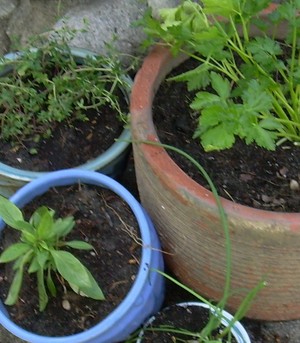For people who love to cook, nothing is better than having fresh herbs at your fingertips. Who doesn’t like the smell of fresh rosemary or mint in the kitchen, or making homemade pizzas with hand picked oregano, thyme, and basil? Herbs are very easy to raise and require just a minimum of fuss. They do quite well in any warm, sunny place and will often flourish in areas where nothing else will grow. I’ve raised herbs in window wells, on balconies, porch steps, and even up against the blazing heat of a foundation wall.
For herbs to thrive, all they really need is a location with plenty of sunshine, and well drained, yet not overly fertile soil.
Where can I plant my herb garden?
Herbs need at least 6-8 hours of sun daily, more is better. In my plant zone, areas with intensive south or west exposure seem to work best. Depending your available space, your herb garden can be planted in either a container, or directly into the ground.
If your garden space is limited to a patio or deck, several herb plants can be grown in a large, but shallow planter. A circular 30 inch round is a great size and can be purchased at most home improvement stores. If you like the look of multiple containers or live in an apartment, half a dozen different flower pots can be grouped to create a striking effect along stairs or on the balcony. Thrift stores and yard sales are great places to hunt for mismatched containers.
I’ve used containers such as tin coffee pots, metal buckets and roasting pans. The containers must have drain holes for the herbs to grow; for a metal container, you can pierce a few holes in the bottom with a large 3 penny nail and a hammer.
For tiny yards, an incredible variety of herbs can be planted in a sunny plot no larger than 36 by 18 inches. Arrange river rocks into a circle to create an herb rock garden (picture #2). Raised beds can also be built out of stacked pieces of concrete, landscape blocks, whiskey barrels, or tin wash basins.
Once you’ve decided on a location, you are ready to buy your herbs.
The type of herbs you’ll want to grow are up to you. Rosemary, parsley, and basil are staples in my kitchen and terrific herbs for beginners. Oregano, cilantro, thyme, chives, marjoram, dill and mint are easy to grow and can be found in most gardening stores. Since my region has a rather short growing season, I usually buy my herbs in 3″ starter pots from the nursery.
Herbs can be either perennial or annuals. Some perennial varieties such as oregano and rosemary, can get quite large and will crowd out other herbs. It is always best to keep them in separate planters. I also plant mint and thyme in separate pots since they spread quite rapidly and will choke out adjacent plants.
The annual varieties of herbs can be combined in a single planter as long as you allow for plenty of space between seedlings. Like all plants, they need room to grow, though aren’t quite so invasive as the perennials. 12-16 inches of space between seedlings is adequate.
How do I plant and care for my container garden?
For a container garden, you will need to purchase composted potting mix and sand from a local nursery. You will also need a bag of potting gravel or a bucket of small rocks. Place the gravel in the bottom of the container, measuring about 1-2 inches. Mix 2 parts of potting mix and one part of sand. Pour the potting mix into your pot until it is about an inch from the rim. Give the potting mix a good watering; let the water drain before planting your herbs. Since potting mix compresses when first watered, it may be necessary to add a little more mix to your container.
Container herbs need just enough water so that the soil feels slightly moist to the touch. Keep them pruned to stimulate new growth, and take care to not over fertilize. Too much fertilizer and quick growth makes the herbs less flavorful. Instead of using chemical fertilizers, consider adding spoonfuls of compost instead. Compost is a earthy, nutrition rich material made from decomposing organic material and can be made quite easily from kitchen scraps and a plastic pop bottle.
How do I plant an herb garden plot?
For a garden plot, you may have to improve the soil slightly before planting your herbs. Your local County Extension Office can guide you. In my yard, the dirt found against curbs and foundations is often hard and alkaline. I usually will break up the hard soil with a hoe, turning to a depth of 12 inches. After the soil has been turned, I’ll add a couple of barrow loads of compost from my yard and a bale of peat moss. If the soil contains too much clay, some sand can help improve drainage.
Once the space has been prepared, the herbs can be planted. Good air circulation is a must, I often mix taller herbs with lower varieties. Perennial or creeping herbs will go into pots to help control their growth. Broken pots that have been tilted into the ground can add visual interest. To keep the garden plot healthy, periodically trowel in some compost into the ground as an alternative to chemical fertilizers.
For more information about herb gardening, the website of the West Virginia County extension office has lots of helpful information for beginners. Their site can be found at http://www.wvu.edu/~agexten/hortcult/herbs/ne208hrb.htm.
